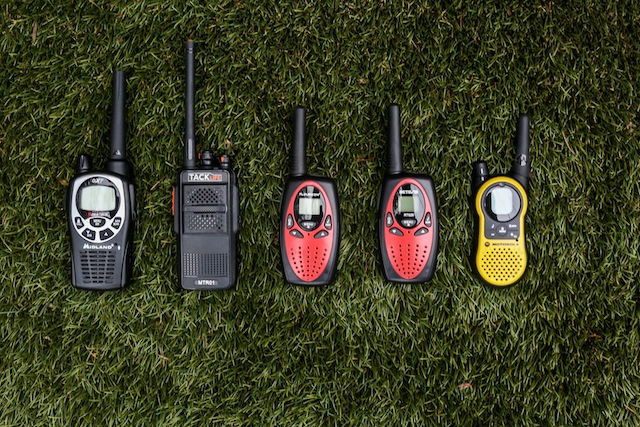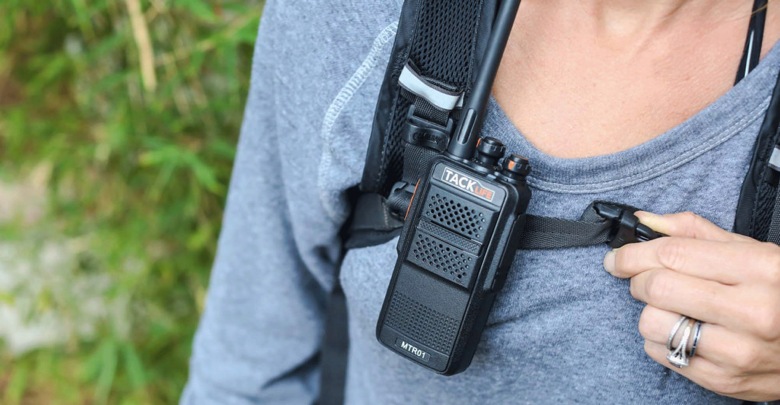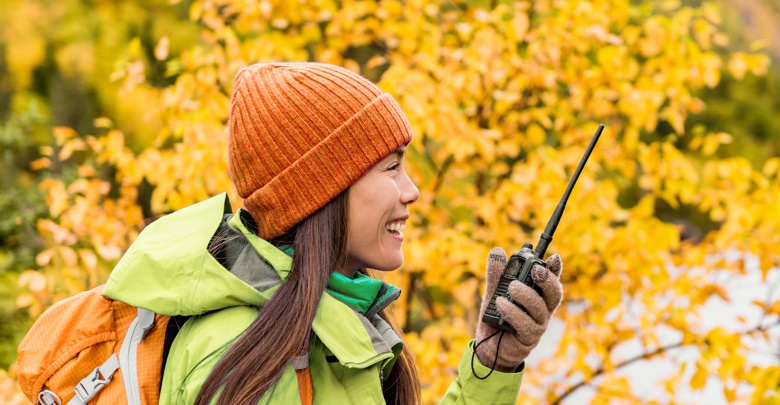Walkie talkies are two-way radios that allow you to easily communicate with others for free and in areas with no cell phone signal. If you’re planning to buy a walkie talkie for your family outing, outdoor camping and hiking adventures or work needs then this article is for you.
After many hours of research, I’ve found the absolute best walkie talkies for everyday use that you can find within a reasonable price range.
#1 Motorola MR350R FRS/GMRS Two-Way Radio
My Top pick
The Motorola MR350R is a great all-purpose two-way radio with an impressive number of features at a decent price.
While the promised range is a far cry away, these walkie talkies will work well for camping and hiking and other outdoor activities within a 1-2 mile radius.
What’s great about these walkie talkies is the privacy codes which allows you lots of different channels to communicate on without other chatter on the channel from interfering.
Whilst these are not the top of the range they are a robust consumer grade walkie talkie with a 23hr battery life (rechargeable) and 20 call tones.
My favorite thing about these is the iVox feature which allows you to keep the communication running smoothly with an ‘open mic’ – this means that when you talk it automatically transmits the call and rings through the other radio.
Awesome features worth mentioning:
- 121 privacy codes across 22 channels.
- 23hr rechargeable battery life.
- 2 belt clips and ergonomic hold.
- iVox open mic feature and 20 ringtones.
Downsides
- Range not as great as promised.
- Not the sharpest sound quality.
Where to Buy?
Best Range
#2 Dewalt DXFRS300 Walkie-Talkies
The Dewalt walkie talkies are rugged, powerful two-way radios that have a very good range. Expect to get 2-4 miles out of these in rugged terrain.
These are very durable and fully waterproof. They can withstand knocks, drops and lots of wear and tear. Perfect for camping expeditions, hiking trails and keeping communication open between neighbors, outdoor workers convoys on a road trip.
What I love about these is that if there is no communication detected within 10 seconds, the device will go into a power saving mode. You’ll still receive and be able to make calls but the device will use much less power – extending your battery life.
The controls are easy to use and you’ll be able to pick up the basics within a few minutes. This is a great set for all day use and works well in all terrain.
Awesome features worth mentioning:
- Rugged design and shock resistant – will withstands 2m drops.
- Voice activated transmission.
- 8-12 hours of battery life under normal use.
- Backed by a lifetime warranty.
Downsides
- Not that cheap.
Where to Buy?
#3 Midland GXT1000VP4 FRS/GMRS Two-Way Radio
These Midland radios are compact, lightweight two-way radios that offer very clear communication across a range of frequencies. The volume is good and they’re easy to operate for first-time walkie talkie users.
Despite the advertised range, expect the real-world range to be within 2-3 miles but less if you’re in an area with more obstructions.
The battery life is good but not amazing. You can expect 16hours of standby but 8 hours of standby and use. The one downside with these is the longer charging time of over 12 hours. You can use AA batteries in the meantime which will give you three days of use – but this will lower the output from 5 to 2-3W and so your the range will be a little smaller.
If you can handle the charging time, then the other features make this a great walkie talkie for your outdoor trips.
Awesome features worth mentioning:
- Small compact size with a decent range across 22 privacy channels.
- Very clear speakers, very little crackle when in range.
- Can handle wear and tear, dirt and mud and some water.
- Accepts AA batteries for multi-day use.
Downsides
- 12 hour charge time.
Where to Buy?
#4 Cobra ACXT645 Walkie-Talkie
The Cobra ACXT645 are a good mid-range radio with a 1-3 mile real world range (not 35 miles as advertised unless in the ocean or in space!). They have 121 privacy codes so you can communicate without fear of anyone listening in.
The take rechargeable batteries that can be charged on a two-port dock – just sit it in while not in use and it will keep it topped up. For adventures further afield, they also take standard AA batteries – perfect for multi-day camping or hiking trips.
This walkie talkie is compatible with a headset for hands-free communication but doesn’t come with these accessories as standard. The built-in flashlight comes in handy if you’re out without a torch.
Awesome features worth mentioning:
- Two-port re-charging dock and takes AA batteries (2-4 days battery life).
- Built-in flash-light comes in very handy.
Downsides
- Advertised as waterproof, but only water resistant and rainproof.
Where to Buy?
Best waterproof walkie talkie
#5 Motorola Talkabout Radio T631
The Motorola Talkabout radio is a rugged, fully waterproof walkie talkie that is perfect for all outdoor use from muddy trails to mountains hikes.
You can use these in heavy rain or drop them in a puddle and they’ll survive just fine. The flashlight will automatically activate when it comes into contact with water and will float on the surface, making it easy to find if you drop it at night time.
The battery offers 9 hours with the re-rechargeable battery (using a micro-USB wall socket) and up to 23 hours when used with 3 AA alkaline batteries.
Out of the box, you’ll get 2 radios, a belt clips, rechargeable batteries, and a dual micro-USB connector for charging both at once.
Awesome features worth mentioning:
- Floats in water and the flashlight automatically lights up.
- Waterproof up to 30m of fully submerged.
- Rugged, ergonomic design is great for outdoor adventures.
- Comes with micro-USB charger and works with AA batteries for longer battery life.
Downsides
- None yet!
Where to Buy?
Key tips to choosing the right walkie talkie

Radio Size
Size is a key factor when choosing a walkie talkie for extended trips. The smaller and lighter the easier it is to carry long distances and the less of a burden it becomes. On the other hand with a smaller frame, you will usually sacrifice some power and battery life.
Battery life
Wireless communication tools are great, but they’re only as good as their battery life. For most people using walkie talkies at home or in their backyard the battery life is not a major concern as you won’t be using them for extended periods of time – and if you are you’re not that far from a power outlet.
When you’re going on a skiing trip or off hiking in the mountains, then battery life becomes more of a concern. Generally battery life over 12 hours gives you a good all day use (turn off at night) and some kits come with a car charger out of the box.
If you’re not near your car or any power outlet and you plan to use your walkie talkie over a multi-day trip, then look for one that accepts AA batteries as well. This will extend the battery life of your radios by 2-3 days but will usually lower the wattage output and so slightly decrease the range you will be able to get.

Radio Channels
For most people using walkie talkies recreationally, the standard radios that you can commercially buy will be fine for communicating easily from one radio to another on the right channel.
A 22-channel radio does not require any licensee or special permission to use and will be great for most people. In the U.S these work on the Family Radio Service frequency which is a band of channels specifically for family use.
Be aware that radios brought from one country to another will not only have different sockets and voltage but they may access the wrong channels.
Different countries have different radio laws – so it’s worth doing a bit of research on this first before using your walkie talkie. Although the chances are slim the last thing you want to do is end up on the wrong channel in the wrong country. Here is a great rundown of the rules governing two-way radio use across the world.
The range
Despite the advertised range of many walkie talkies – these are often exaggerated or only possible in unnatural conditions (flat, un-obstructed landscapes like Utah’s salt flats). For most real-world scenarios where you are communicating across valleys, woods and mountainous regions – the actual range is much less.
While a walkie talkie might be advertised as 30 miles or more, expect 2-3 miles at most.
Radios that output more power will have more of a range and the type of batteries you use will affect the output. The standard rechargeable battery that comes with the radio will have the highest output, but using AA batteries as a replacement will result in a reduction of output – but will usually triple your battery life.
How to extend your range
GMRS
For those that need more power or a greater range, then you can use a radio that is compatible with GMRS frequencies. You will need a license to operate in these ranges but you’ll benefit from a 20+ mile range.
If you’re a business or looking for a serious extension of your range then GMRS is the way to go. For campers, hikers and most recreational user the standard range that you get with an FRS unit will usually be sufficient.
Line of sight
Different environments will increase or decrease your range. The more obstacles that lie between you and the receiver the more likely it is to block out the signal. To improve your range, try to stay out from walls, hills and trees. Of course, this is not always possible, but if communication is critical then try to get to a high or open space.

Weather
The conditions of the day can have a dramatic effect on the signal. The best conditions are bright bluebird days, while the worst tend to be windy, foggy or stormy days.
Read my article If you’d like to know more about extending your walkie talkie range.
Privacy Codes
If you don’t want to worry about signal interference, then choosing a walkie talkie with privacy codes is a great idea.
Despite the name, privacy codes won’t make your chatter private, as other walkie talkie models without privacy codes or radio receivers can listen in. But if you’re using privacy codes it means that others not on the same code can’t broadcast to you. This is particularly useful if your in busy areas where the 22 channels may be crowed or you don’t want to waste battery power listening to other radio chatter that’s not relevant to you.
Privacy channels filter out other signals that are not on the correct code. If you are in a group and want to communicate with someone without a privacy code compatible radio then you can turn off your privacy codes. That way you’ll both be able to receive and make contact with one another.
NOAA Radio
If you’re looking for up to date weather reports then buying a walkie talkie with NOAA compatibility gives you access to 24/7 broadcasts and warning of any potential hazards.
You’ll simply need to tune your two-way radio into the correct channel and be in the U.S. Other countries and territories will have their own broadcast systems to receive broadcasts.
Walkie talkie FAQ
1. How far can I communicate?
While each walkie talkie brand and model is different the quotes range in product descriptions is often wildly inflated and presumes unobstructed clear terrain.
In real-world cases with most mid-range walkie talkies expect a range of no more than 3 miles. Typically ½-2 miles is to be expected, especially when there are trees, hills and buildings in the way or one of you is in a valley.
The signal is unlikely to travel far between valleys and you should travel to high ground if you want to communicate with someone in the nearby valley.
2. How long will my battery last?
Most walkie talkies will give you a full day of standby power and 8-12 hours of low to moderate use. The final number depends on the size of the battery, the efficiency of the radio, the power output and how much you use the radio.
To extend your battery life you can travel with AA batteries which can be used with most walkie talkie models as a backup. These batteries will extend the life from 1-3 days but will lower the power output in most cases (and therefore the range) – but are great for extended multi-day trips.
3. Do I need a license to use my radio?
Generally no. In the U.S a push button 22 channel radio does not require a license and operates within the family radio frequency.
If you’re planning to use GMRS or HAM then you will need to register for a license or permit. In other countries check your local laws – some areas have very strict rules governing radio use.
If you stick with recreational radios and use the standard channels, then you’ll be fine without requiring a special license.
4. Do I get two radios when I buy online?
In almost all cases the two-way radio sets are sold as pairs and you do get two different walkie talkies that you can communicate with.
In some cases, manufacturers may sell one radio as a replacement or special use case, but check the product description and images to see that two radios come with the kit.
Conclusion
Walkie talkies are fun, useful and in extreme conditions can be lifesavers. Whether you’re planning on keeping in touch with family members or neighbors or planning a trip to the mountains, walkie talkies are lightweight, reliable ways of staying in communication.
The reviews above are completely independent and my pick for the best consumer grade two way radios on the market at the moment. I hope the reviews are useful and help you make a decision in which one to choose.










